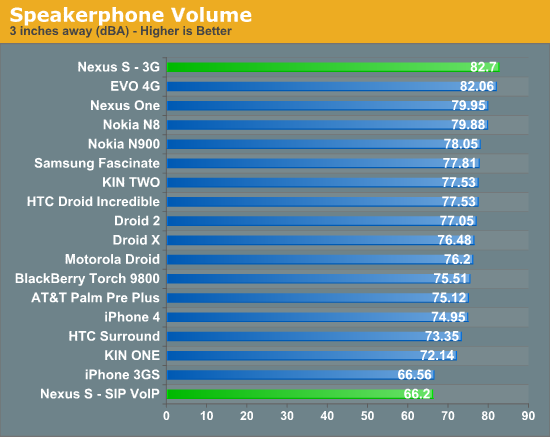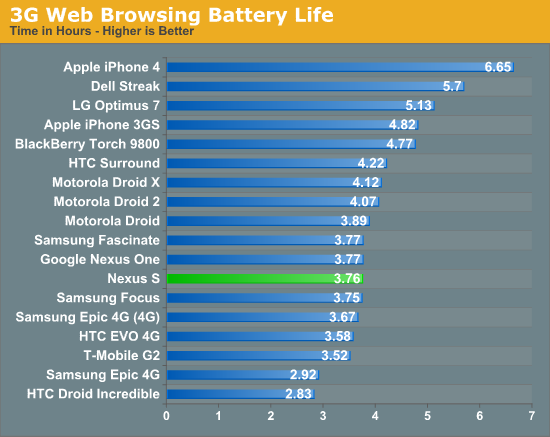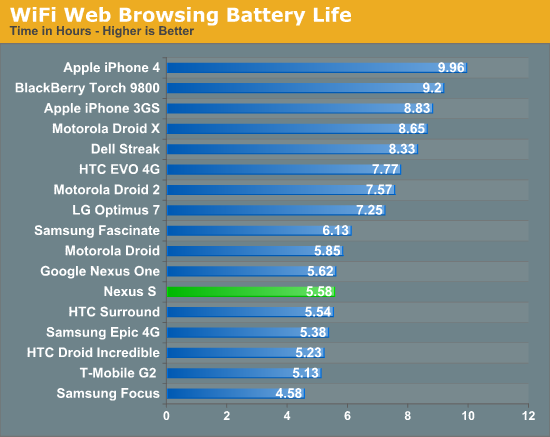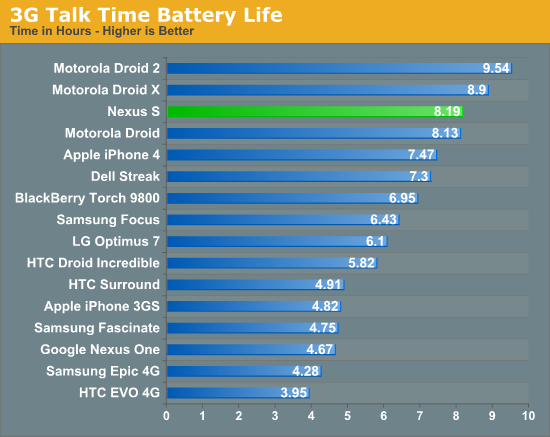Nexus S and Android 2.3 Review: Gingerbread for the Holidays
by Brian Klug on December 14, 2010 4:08 PM EST- Posted in
- Smartphones
- Samsung
- Nexus S
- Gingerbread
- Android 2.3
- Mobile
Speakerphone, Voice, Battery
So I mentioned earlier that the Nexus S speakerphone is a bit quiet when calling with SIP VoIP. I think that’s an understatement - it’s extremely quiet when making a SIP call. Again these tests are the same way we’ve run all our other speakerphone tests - 6” above the device with our USB datalogger.
The Nexus S is louder than the Nexus One for normal calls, however. Speakerphone at maximum volume has a bit of distortion, but one volume notch down it goes away entirely. I thought speakerphone voice quality was very good. Earphone volume is acceptable if a tad on the quiet side, but then again I think the same thing for nearly every other handset. Voice quality on the earphone is exactly what I’m used to for UMTS voice. There’s software noise cancellation for video, but I can’t locate a second microphone on the Nexus S for noise cancellation in calls. Having that second microphone was a big deal for the Nexus One, so I’m surprised it’s absent in the Nexus S - if it’s there, I at least couldn’t find it.

Battery life on the Nexus S is actually shockingly close to the Nexus One. So much so that it’s honestly scary in the case of 3G and WiFi browsing time. 3G Talk time on the Nexus S is far better than the Nexus One. We of course ran our normal suite of tests for 3G and WiFi browsing time, loading through a couple dozen pages with the screen at 50% brightness, extraneous processes killed using a task killer, and the display on. For the talk time test, we play music at both ends, allow displays to sleep, and take the total talk time. I noted that the Nexus S fell back to GSM voice three times, each time I reinitialized the call after the Nexus S reacquired UMTS. I’m going to run this test again and update if necessary - just know that’s what happened if these numbers change.



The Nexus S includes a slightly bigger battery than the Nexus One (5.55 Whr versus 5.2 Whr). I’m a bit surprised battery life didn’t improve just a bit more between the two.










73 Comments
View All Comments
Zingam - Thursday, December 16, 2010 - link
I agree I have a nokia and the phone jack is on the top side. I have wished many times that it is on the bottomcece74 - Thursday, December 16, 2010 - link
I also miss the trackball on my Galaxy S.But I now use Swiftkey , a pretty good keyboard, and it also have arrow keys (press "123" then symbols : {&= key) to see it.
JimmiG - Thursday, December 16, 2010 - link
Basically a Galaxy S (which was basically a Nexus One with a better screen and faster GPU), with a few extra features, unlike the Nexus One which was pretty revolutionary for its time.Of course, the Nexus One isn't even a year old, which isn't such a long time.. but sometimes it feels like the N1 was released in another decade considering how fast things have moved. I hope the Nexus 3 or whatever at least as a dual-core out-of-order CPU and other improvements.
blueF - Thursday, December 16, 2010 - link
Well I purchased my Nexus S, and am very pleased with the phone. Scrolling is not as smooth as I was lead to believe, but still glad I purchased one.bobshute - Thursday, December 16, 2010 - link
Brian, are you sure on the 3G radio.The T-mobile Samsung Vibrant radio, although not advertised, is at least Quad band
It has the 1900 radio on by default for 3G on AT&T.
You can also turn on the 850 band in the service menu although it's not confirmed to work in 850 mhz only areas of AT&T coverage.
Voldenuit - Friday, December 17, 2010 - link
>Don't you usually have your phone in your pocket upside down anyway?Not if it's in the shirt pocket. Or jacket inner pocket. Or on a belt holster.
I'm a lot more likely to use a headphone with the phone in these places rather than in my pants pockets, where walking, sitting or standing up is more liable to crush/damage the headphone jack.
Inuit - Saturday, December 18, 2010 - link
A new on-screen keyboard for Android from Keypurr has directional keys, and it is in the main screen (no need to flip to another screen). I am using Keypurr on my Galaxy S - and love it!In addition, it has large keys (almost twice as large as the standard keyboard) and very clever and up-to-date dictionary. I can type on it as fast as hardware keyboard, or type one handed. It also comes in black or white skins, has function keys, and more. I think Keypurr has some good short videos on their site: www.keypurr.com
keypurrtech - Sunday, December 19, 2010 - link
Keypurr is a new Android keyboard that uses a full QWERTY layout with keys that are are almost twice the size of other onscreen QWERTY keyboards. It also has a dictionary that includes abbreviations, acronyms, and words borrowed from other languages. Best of all for Nexus S users (and anyone who's phone doesn't have a trackpad) it includes customizable function keys that can be used as directional controls.Keypurr allows users to type with greater speed, confidence, and ease, than any Android keyboard! Check out our website: www.keypurr.com or our youtube channel: www.youtube.com/keypurrtech to learn more.
teohhanhui - Monday, December 20, 2010 - link
"... people want carriers to provide first-party support for devices, and people want to play with devices in stores before making the jump ..."I wouldn't consider a carrier as the first party when it comes to providing support for phones (there is no doubt that they are the first party when it comes to network issues). As it stands, carriers are only worsening the experience by slapping on unwanted customizations and hindering roll-outs of OS updates.
What is stopping you from "playing with devices" in a retail store (either by manufacturer/OS vendor/authorized reseller)?
IMO the real reason for the prevalence of "carrier subsidies" seems to be consumers preferring to pay by installment, or simply unaware of the fact that they end up paying more in the end.
ravenfq - Tuesday, December 21, 2010 - link
I'm always disappointed to find that no reviewers mention the fact that Android doesn't support WiFi proxy 'out of the box' - any suggested solutions to this lack of functionality require that the user 'root' their device, which is not necessarily acceptable to everyone (for all sorts of reasons).This lack of functionality precludes student usage on campus, and crucially (in my opinion) any corporate in-house 'managed' usage, where any WiFI authentication is a pre-requisite.
As a CIO, I'm forced to eliminate Android-based devices from consideration as a corporate standard, and constrain my options to Apple, Microsoft and (hopefully) any upcoming HP WebOS-based devices.
This is deeply disappointing to me personally, as I applaud any attempt to separate the OS from the hardware, liberating hardware manufacturers to compete and innovate, and thus giving us, the end users, ever expanding and increasing capabilities in a portable device. I had high hopes for the relatively open Android environment in this regard.
I would also refer you to this (somewhat emotive) link that outlines the issue in more detail:
http://code.google.com/p/android/issues/detail?id=...
Thank you, Anandtech, for what is otherwise superb technical journalism.